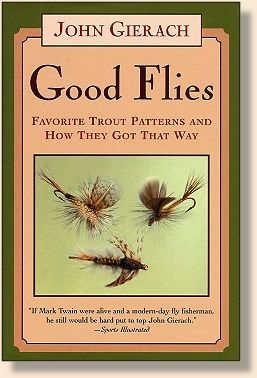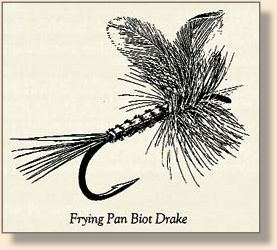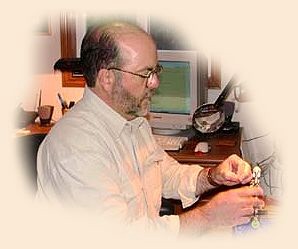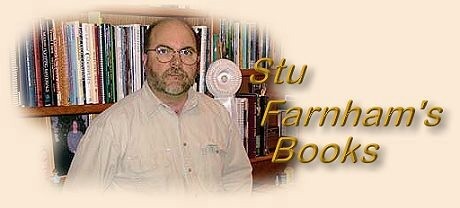|
The Internet is a powerful resource. It provides us instant
access to information, and brings us together via email,
bulletin boards, chat rooms, and instant messaging. FAOL
is a wonderful example of the Internet at its best. The Internet,
however, will never replace the printed page.
I've loved books and fishing since my youngest years, although
I did not start fly fishing until 1993. This column will give
me an opportunity to share reviews of some of my favorite fly
fishing and tying books (and some that are not such favorites)
with my friends here at FAOL. My library reflects my tastes
and interests, and so will this column. It will be heavily
slanted towards cold water fishing and tying for trout and
steelhead, and won't touch much on areas of which I know little,
such as warm or salt water fishing.
I hope that these reviews will motivate some of you to pick up
a good book, on this or any subject, and read.
~ Stu Farnham
Good Flies: Favorite Trout Patterns and How They Got That Way
 Good Flies:
Good Flies:
Favorite Trout Patterns and How They Got That Way
by John Gierach
Hardcover: 179 pages
Publisher: The Lyons Press
ISBN: 1585741396; (November 2000)
OK, I'm probably the only fly fisher in North America
who does not rate John Gierach among my favorite writers.
It's not that I dislike his work; most of it just doesn't
do much for me. Besides, as anyone who reads this column
regularly knows, I tend more towards technical books on
fly tying and on fishing technique than I do "soft" books
of fishing experiences and anecdotes. Even John's
"hard" books - Fishing Bamboo and Fly
Fishing Small Streams - did not really get me excited.
Good Flies, however, is another matter. It's written from
the point of view of a fishing fly tier, a fly-tying
pragmatist, describing the flies that work for Gierach,
and his methods for tying and fishing them.
 The introduction presents some of Gierach's history as a
tier, and his philosophy of tying. "I prefer flies that
are more or less traditional, that don't sue rare, exotic,
endangered, or unusually expensive materials, and that are
fairly easy for me to tie well in fishable numbers. On
the other hand, I'll break any or all of those rules for
a pattern that really catches fish."
The introduction presents some of Gierach's history as a
tier, and his philosophy of tying. "I prefer flies that
are more or less traditional, that don't sue rare, exotic,
endangered, or unusually expensive materials, and that are
fairly easy for me to tie well in fishable numbers. On
the other hand, I'll break any or all of those rules for
a pattern that really catches fish."
The chapter on materials, tools, and hooks isn't the usual
rehash of the basics. Instead, Gierach talks about his
preference for natural materials and hen hackle wings
(the latter shared with his friend A.K. Best, who, as
usual, turns up throughout the book). Another thing
Gierach has in common with Best is a preference for
turkey T-base feathers for wings and posts. John goes
on to talk about the various feathers and feather parts
he uses in tying, his preference for rabbit fur dubbing,
and quill and biot bodies. Hooks: three or four styles
cover most of Gierach's needs, with another three or
four for specialized use. The tools section provides
an overview of the basic set that Gierach uses. No
real revelations here.

The remainder of the book covers Gierach's favorite patterns
(few, if any, original with him) to imitate various categories
of fish food: small, medium, and large mayflies as well
as mayfly spinners; midges, caddis, damsels, and hoppers;
nymphs; and streamers. Each chapter has textual
descriptions of the flies, with all of the recipes
gathered together at the end of the chapter. Barry
Glickman's black and white drawings accompany the text.
Among the patterns that have made their way from
this book to my fly box are the duck shoulder version
of the Swisher/Richards no hackle, and a soft hackle
Gierach calls the Palm Emerger; the hare's ear parachute;
the biot green drake parachute, with a pair of hen
hackles forming the post; and Ken Iwamasa's Tarcher
nymph. Probably my favorite idea out of this book is
the use of appropriately colored Clousers to imitate
crayfish. The hook-up carriage of this fly is ideal
for bumping along the bottom in a very crayfishy
manner without snagging.
This isn't the most complete book of patterns ever
published. It won't teach you a lot about tying technique.
Most, if not all, of the flies described were developed
by someone else and have been described somewhere else.
I don't reach for it often as a reference. But it's a
quick, enjoyable read and you'll probably pick up a
few new patterns and some tips for tying and fishing them.
~ Stu Farnham
About Stu
 Stu Farnham is a New Englander by birth, who was transplanted to
and put down roots in Oregon in the early 1990s, now residing in
the Seattle area. A software engineering manager by vocation,
he can be found in his spare time chasing trout and steelhead
in the rivers of the Pacific Northwest, chasing his four Gordon
Setters (who in turn are chasing chukar), tying flies, reading,
or working on his website. Colleen, his long suffering wife of
28 years, is a professionally trained personal chef.
Stu Farnham is a New Englander by birth, who was transplanted to
and put down roots in Oregon in the early 1990s, now residing in
the Seattle area. A software engineering manager by vocation,
he can be found in his spare time chasing trout and steelhead
in the rivers of the Pacific Northwest, chasing his four Gordon
Setters (who in turn are chasing chukar), tying flies, reading,
or working on his website. Colleen, his long suffering wife of
28 years, is a professionally trained personal chef.
|

 Good Flies:
Good Flies: Stu Farnham is a New Englander by birth, who was transplanted to
and put down roots in Oregon in the early 1990s, now residing in
the Seattle area. A software engineering manager by vocation,
he can be found in his spare time chasing trout and steelhead
in the rivers of the Pacific Northwest, chasing his four Gordon
Setters (who in turn are chasing chukar), tying flies, reading,
or working on his website. Colleen, his long suffering wife of
28 years, is a professionally trained personal chef.
Stu Farnham is a New Englander by birth, who was transplanted to
and put down roots in Oregon in the early 1990s, now residing in
the Seattle area. A software engineering manager by vocation,
he can be found in his spare time chasing trout and steelhead
in the rivers of the Pacific Northwest, chasing his four Gordon
Setters (who in turn are chasing chukar), tying flies, reading,
or working on his website. Colleen, his long suffering wife of
28 years, is a professionally trained personal chef.
 The introduction presents some of Gierach's history as a
tier, and his philosophy of tying. "I prefer flies that
are more or less traditional, that don't sue rare, exotic,
endangered, or unusually expensive materials, and that are
fairly easy for me to tie well in fishable numbers. On
the other hand, I'll break any or all of those rules for
a pattern that really catches fish."
The introduction presents some of Gierach's history as a
tier, and his philosophy of tying. "I prefer flies that
are more or less traditional, that don't sue rare, exotic,
endangered, or unusually expensive materials, and that are
fairly easy for me to tie well in fishable numbers. On
the other hand, I'll break any or all of those rules for
a pattern that really catches fish."